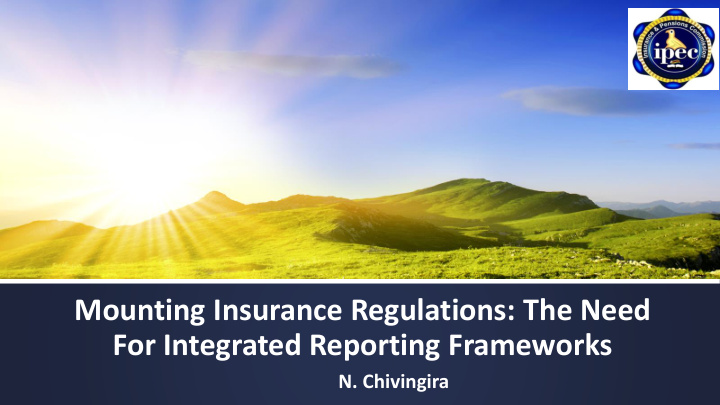



Mounting Insurance Regulations: The Need For Integrated Reporting Frameworks N. Chivingira
Outline ▪ Evolution of insurance regulation in Zimbabwe ▪ Drivers of changes in regulations ▪ Notable changes in regulations ▪ Implications of changing regulatory landscape ▪ What insurers need to do? ▪ Conclusion ▪ Questions
The Road/Evolution Of Insurance Regulation in Zimbabwe
The Evolution Journey ▪ The current Insurance Act [ Chapter 24:07 ] enacted in 1988 and Insurance Regulations of 49 of 1989 ▪ Regulation of the insurance industry under a department in the Ministry of Finance and Economic Development up to 31 Dec 2005 ▪ IPEC created as a statutory body beginning the 1 st of January 2006 ▪ Regulation migrating from rules based to principles based approach
Why the Change in Regulations? ▪ Evolution of insurance regulation has been mainly driven by the following factors: a) increasing diversity of insurance products, distribution channels b) increased need for consumer protection c) the need to boost confidence in the financial systems d) the geographic extension of insurance markets with a number of insurers operating on a national and international basis e) regional and international best practices
Notable Changes in the Regulations ▪ A number of statutory instruments and circulars issued over the years covering several aspects; Investment guidelines - unlike in the past, insurers are now required to comply with certain investment thresholds as prescribed from time to time; Capital requirements - capital requirements becoming more stringent than in the past; Governance - tighter governance controls relative to those that prevailed before dollarization;
Notable Changes in the Regulations Risk management - more robust risk management requirements compared to risk management practices that prevailed in past; Product design and pricing - approval of new products by the Commission became mandatory in 2016; Mandatory actuarial input in pricing and reserving for all classes of insurance business; AML/CFT; and Micro-insurance framework.
Upcoming Changes
Upcoming Changes ▪ Regulatory frameworks - All 3 bills currently under review ▪ Risk based capital framework similar to SAM, Solvency 2 - this will require insurers to increase their skills base, as well as upgrading their information technology systems ▪ Development of mortality tables which will affect pricing and reserving ▪ IFRS 17 - insurers now required to do dry runs before the implementation date of 2021
Implications of the Mounting Regulations ▪ A call for an integrated reporting framework which covers the following blocks/elements ✓ Organisation overview and external environment ✓ Business model, organisational strategy and policies ✓ Capital - financial, human, intellectual and other forms of capital ✓ Governance ✓ Stakeholder identification and relationships - insurers need to work with a number of professionals to come up with appropriate reports
Example of An Integrated Reporting Framework Other Project Management Office IT Support Compliance Investor Management Capital Planning Modeling Risk Finance Actuarial Investment Accounting Other Management ORSA Sensitivities Financial Soundness reports Solvency II IFRS Type of Reporting
Implications of the Integrated Reporting Framework ▪ The integrated reporting framework may mean increased costs of running the business in short to medium term since there is need for; ✓ robust IT infrastructure ✓ appropriate human capital to facilitate integrated and timely reporting ▪ However, in the medium to long term insurers will enjoy ✓ Increase in confidence levels in the insurance industry facilitating industry stability ✓ Long term profits as a result of increasing revenues
How Can Insurers Stay on Top of Changing Regulatory Environment?
What insurers need to do? ▪ Identify and build relationships with all the key stakeholders ▪ Integrated reporting framework requires skills from various professions ▪ Different types of reports are now being requested from insurers ✓ monthly, quarterly, annual basis or adhoc ▪ Immediate need for insurers to have ✓ Digitalised processes ✓ Big data analytics
What Insurers Need to do? ▪ Monitoring and anticipating regulatory changes far enough in advance to allow for implementation―particularly in systems― and to prevent potential side effects associated with imposing one standard over another ▪ Reassessing current status and being able to share this information with the regulator and other key stakeholders (progress reporting, problems encountered, actions taken and other items) ▪ Gauging the extent of required changes to meet reporting standards (in terms of IT, process, organization and methods)
Conclusion ▪ The regulatory landscape will continue to evolve as long as the insurance industry exists due to either local, regional and international experiences ▪ This therefore calls for insurers to engage at all levels and be able to adopt to the changing regulatory landscape in order to remain in business ▪ Changes that have happened elsewhere in the world will subsequently pass on to the remainder of the world. There is therefore no need to ignore things happening outside where you operate from.
Questions
Recommend
More recommend